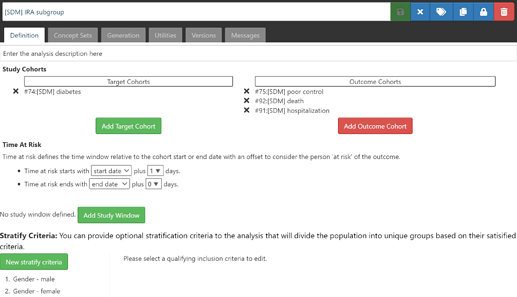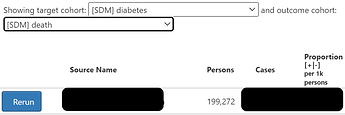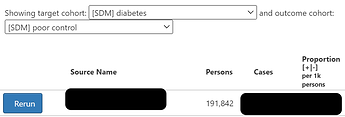Hi! I hope you are well.
For context, I’m investigating the rate of poor control, hospitalization, death among those identified as having diabetes (as attached).
However, when running the analysis, the numbers of diabetic patients from three data reports, which presumably should be the same because of having the same target cohort, are different. This discrepancy persists regardless of whether I specify censoring events for the target cohort or not.
So, I am wondering what’s the cause of this issue and where I should begin troubleshooting. Thanks for any advice or comments.
Best,
Shanshan
In Atlas, we exclude prior outcomes from the analysis. So, the difference in numbers is because for one outcome you had some number of priors that disqualified the person from analysis, and in another outcome you had a different number of people excluded.
1 Like
Thanks, Chris!
So patients with diabetes who had prior hospitalization before being diagnosed with diabetes might be excluded if the outcome is hospitalization? Is there any approach to avoid their exclusion?
I feel like this makes sense when the outcome of interest is non-recurring, such as death. For recurring events like hospitalization, we lose information because of that.
Thanks,
Shanshan
It also makes sense in the case where you are concerned that a prior outcome will impact the chances of a recurrent outcome. Some people think of ‘incidence’ as a first-ever outcome, so people witht he prior out come would be ‘immortal’ if they were included.
To make this work in a more ‘time to event’ mode of thinking, you’d have to define custom outcomes for each target where the outcome must occur after the target cohort. In this way, outcomes won’t cause people in T to be excluded because the outcomes will only happen after T.
1 Like
I agree!
Do we need to write sql code for the incidence rate analysis? I tried to specify it in the cohort definition, but it doesn’t seem to be working.
Thanks again,
Shanshan
Only if you think you can’t apply the logic into your target and outcome cohorts.
For example, your T2DM with prior hospitalization, you want to get an incidence of hospitalization:
Target Cohort: T2DM with prior hospitalization
Outcome Cohort: Hospitalization with Prior T2DM ( maybe include that the T2DM had to have prior hospitalization)
This outcome cohort will only be an outcome if it occurs after a T2DM diagnosis (with the prior Hospitialization)… Effectively this is an ‘outcome after target’ cohort that shouldn’t exclude anyone.
I’m not sure if you have more advanced use cases, but that’s the general approach if this is the sort of thing you’re trying to do.
You can also look at the analysis SQL in atlas, copy it out and modify it in a way that suits your purpose, but I can’t guarantee you won’t introduce errors.
1 Like



